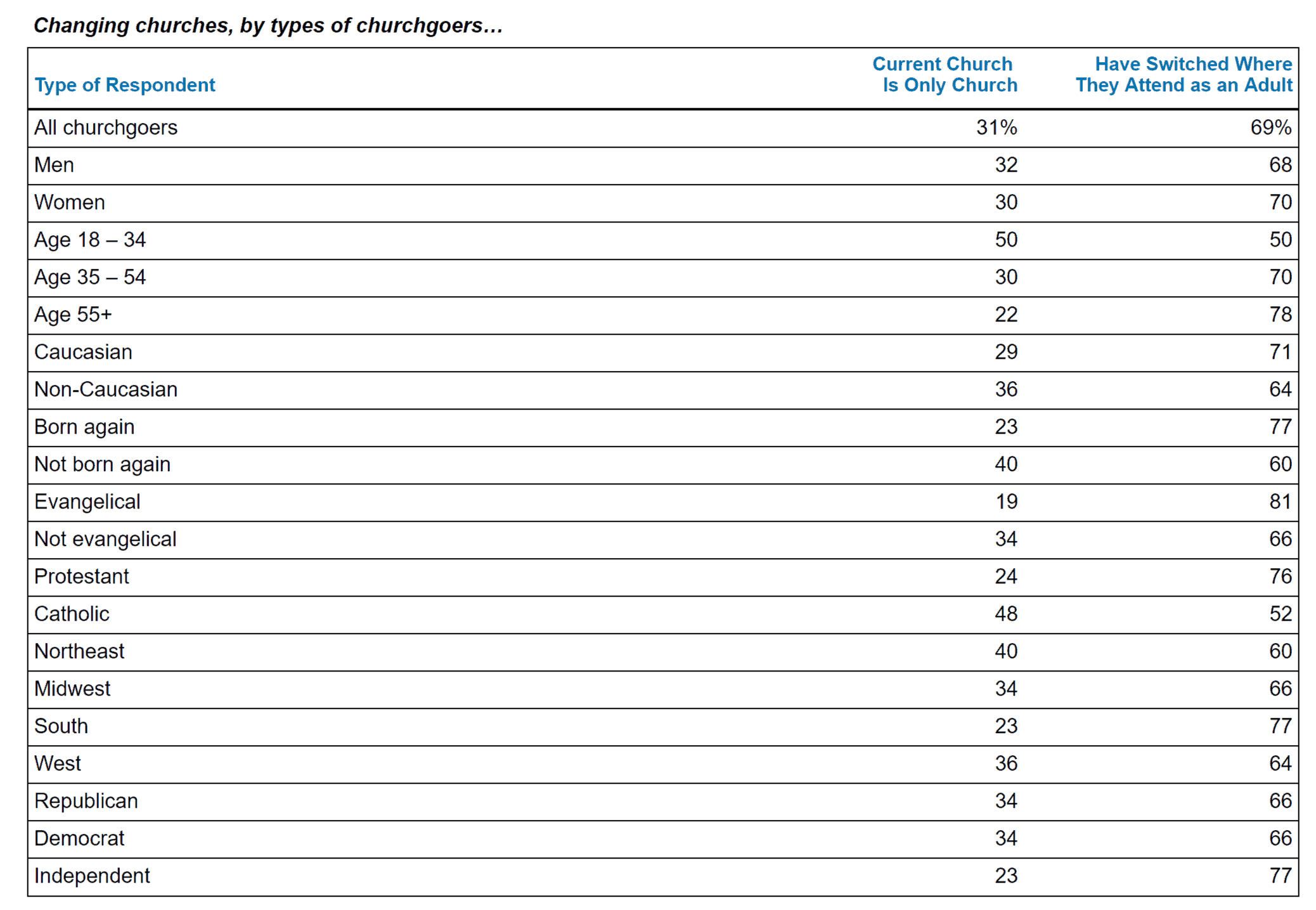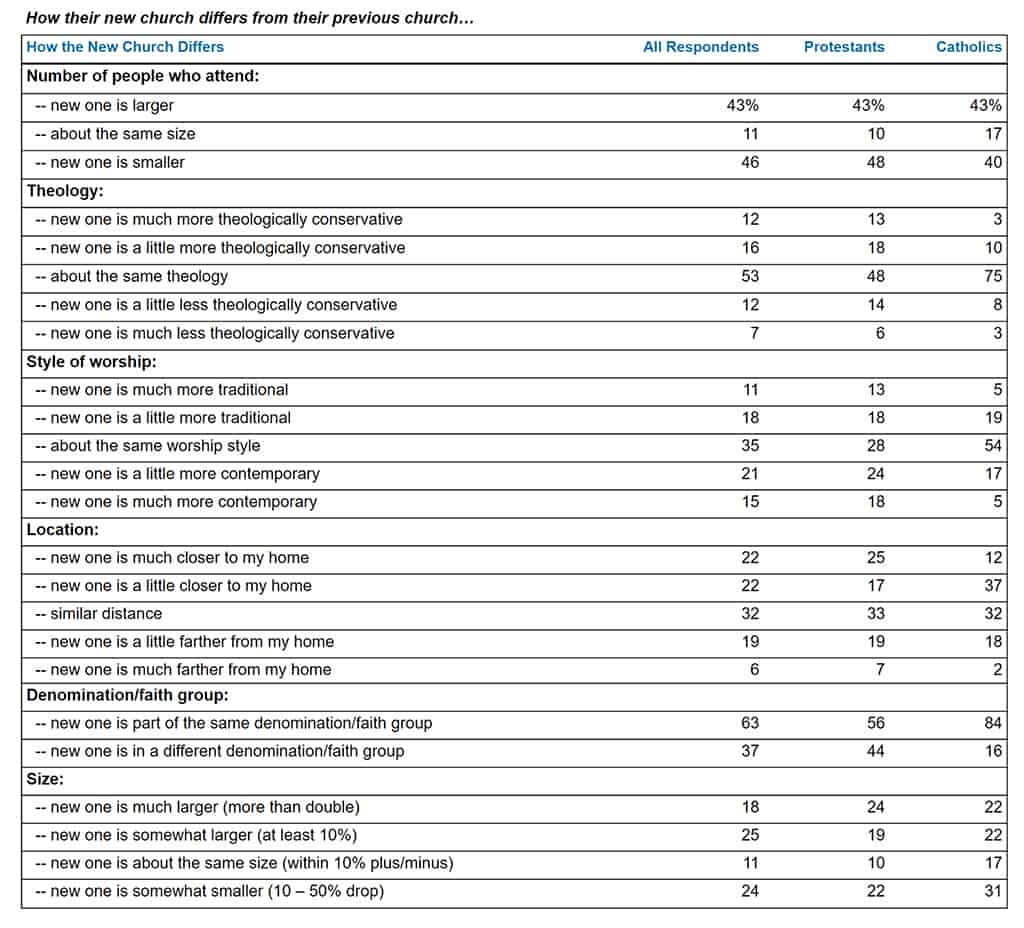When people change where they worship, they often change to a different style, size, and theology of church as well
(Original release date: May 22, 2008) Study results released from Grey Matter Research & Consulting (formerly Ellison Research) of Phoenix, Arizona show most Americans who currently attend religious worship services have changed where they attend at some point during their adult lives.
The findings are from a study independently designed, funded, and conducted by Grey Matter Research among a representative sample of over 1,000 American adults, including 517 who regularly attend religious worship (once a month or more). Grey Matter Research is a full-service marketing research firm.
The study asked Americans who attend worship services whether they have regularly attended a different place of worship from the one they are attending now, and how their current place of worship differs from their former one. The research focused on individual churches, temples, or houses of worship, not just whether people have switched religions or denominations.
Sixty-nine percent of all Americans who currently attend worship services have attended more than one place of worship as an adult, while 31% report that their current place of worship is the only one they have regularly attended since age 18. As might be expected, this varies a lot by age; among adults under 35, 50% have switched where they worship, but this number is 70% among people 35 to 54, and 78% among those 55 or older.
This number also varies quite a bit by faith group. Among Roman Catholics, only 52% have moved to another parish at some point, while among Protestants, 76% have switched churches. Evangelicals are particularly likely to have switched churches (81%, compared to 67% among all non-evangelicals who attend services).
In a majority of cases, people who switch where they worship are those who move to a different home at the same time. Although the study did not concentrate on why people switch where they worship, there is clearly a connection between changing residences and changing places of worship, particularly for Catholics. Among people who changed where they worship, 69% also changed where they live, including 65% of Protestants and 80% of Catholics.
The study also explores how the new place of worship differs from the previous one. Overall, people who change where they worship usually move someplace that has a different worship style and a different size. Around half find a new place to worship that has noticeable theological differences from their old one, and just under half move to one that is closer to home. Over a third change denominations or faith groups.
When people switch where they worship, that switch usually includes some change in worship style. Just 35% believe their new place of worship has a worship style that is similar to their last location, while 29% say it has a more traditional worship style, and 36% moved to a more contemporary style of worship.
Among Protestants who switched churches, 31% have noticed a more traditional worship style, 42% believe it’s more contemporary, and just 28% feel it’s about the same as their last church. But even many Catholics feel their new parish has a worship style that differs from their old one – 24% feel it’s more traditional, 22% feel it’s more contemporary, and 54% haven’t noticed any real difference.
Most also go to a place of worship that is a different size than their former one. Just 11% switch to someplace that is about the same size (within 10% plus or minus) of the place they left. But there is no consistent preference for larger or smaller congregations. Forty-three percent left for a larger congregation (including 18% who say the new place of worship is more than double the size of the old one), while 45% moved to a smaller congregation (including 21% who say it is less than half the size of the old one). There is relatively little difference between Catholics and Protestants on this point, although Catholics are less likely than Protestants to move to a much smaller parish.
Theologically, 53% of adults who have changed where they worship say their new place of worship is about the same as their old one. Twenty-eight percent moved to a place they feel is more theologically conservative, including 12% who say it is much more conservative, while 19% moved to one that is more theologically liberal (including 7% who feel it is much more liberal). Protestants are much more likely to notice a difference theologically between their old church and their new one (52%), while Catholics largely see consistency (just 25% note a theological difference).
When they switch, many people find someplace to worship that is closer to home. Just 32% say their current place of worship is about the same distance from their home as the old one, and 25% are now traveling farther to worship, while 44% report their new place of worship is closer to home (including 22% who say it is much closer to home). The findings are similar for Catholics and Protestants.
Thirty-seven percent of all Americans who have changed where they worship report that when they changed locations, they also changed denominations or faith groups. This was particularly common among Protestants (44%), who of course have the option to move around to a number of somewhat similar denominations, or make a complete change in their denomination or faith group.
Ron Sellers, president of Grey Matter Research, noted that the study helped demonstrate what is really happening in the worship landscape today. “The findings show a lot of individual change, but not a lot of broad trends,” Sellers stated. “Most people go to a place of worship that’s a different size, but there’s no strong trend toward finding smaller congregations or larger ones. There’s also a lot of change in worship styles, but not a big overall trend toward going someplace more contemporary or more traditional. So it’s not as if one form of worship or style of church is moving to become much more dominant in the American religious landscape.”
Sellers also suggested that this research may put to rest some existing myths and concerns. “With the rise of megachurches over the past few decades, and the increase in the use of contemporary forms of worship such as rock music, drama, or the folk mass, two common concerns are that traditional forms of worship are dying out, and that small churches may become a vanishing breed. There has been a slight trend toward more contemporary worship styles among people who switch where they worship, but certainly not a wholesale move away from traditional styles. And there has been just as much movement toward smaller congregations as toward larger ones. Observers may worry about people leaving small congregations and going to the megachurches, but they need to realize there are about as many people moving down in size as moving up.”
He also cautioned against misinterpreting the study results. “This research shows what people are changing, but it doesn’t address why. One person might change to a much smaller church or temple without size being a significant factor in their choice, while another person can consciously decide they want to move to someplace smaller and more intimate. This research shows what is happening out there, but it’s not accurate to pinpoint any of these changes as motivating factors when people switch where they worship.”
Study Details:
The study was conducted by Grey Matter Research (formerly Ellison Research), a marketing research company located in Phoenix, Arizona. The sample of 517 adults who attend worship services is accurate to within ±4.2 percentage points at the 95 percent confidence level with a 50 percent response distribution.
The study was conducted in all 50 states. Respondents’ age, household income, geography, racial or ethnic background, and gender were carefully tracked to ensure appropriate representation and accuracy.



